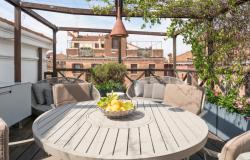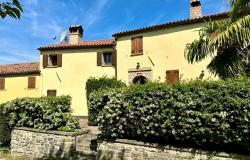The smart city of Padua (Padova in Italian) in the wealthy north-east Veneto region usually has to play second fiddle to Venice, yet it demands sightseeing in its own right. Situated 36 kilometres west of Venice, this city populated by 220,000 took its name from the later Roman settlement of Patavium.
Padua has none of the frowning frenetic rush of Milan but emanates an easy-going elegance and confidence achieved through a blend of thriving business and well-established university and research facilities.
Moreover, crammed with dazzling art treasures, this particularly pleasant city rewards unhurried visitors with lively markets, excellent fashion shopping and swathes of green parkland lining navigable canals. Forgetful? Can’t remember where you put the car keys or that overdue library book? Then a visit to the shrine of il santo, Saint Anthony, might just be beneficial. Spacious Piazza del Santo in Padua’s southern district surrounds rambling cloistered monastery premises and a cavernous art treasure-trove Basilica, an austere soaring Gothic-style church (open 6.30am-7pm daily) sporting spires that resemble minarets. It draws pilgrims from all over the world who flock to pay homage to the venerated Portuguese - born 13th - century Franciscan friar, also the acknowledged master for locating lost objects not to mention a spouse for spinsters; orphans and shipwrecked seamen also invoke his assistance, as do both expectant mothers and sterile women!
Forgetful? Can’t remember where you put the car keys or that overdue library book? Then a visit to the shrine of il santo, Saint Anthony, might just be beneficial. Spacious Piazza del Santo in Padua’s southern district surrounds rambling cloistered monastery premises and a cavernous art treasure-trove Basilica, an austere soaring Gothic-style church (open 6.30am-7pm daily) sporting spires that resemble minarets. It draws pilgrims from all over the world who flock to pay homage to the venerated Portuguese - born 13th - century Franciscan friar, also the acknowledged master for locating lost objects not to mention a spouse for spinsters; orphans and shipwrecked seamen also invoke his assistance, as do both expectant mothers and sterile women!
The gleaming tomb of Saint Anthony is visited by a constant flow of the faithful, as is an exquisite gem-studded 1436 reliquary that houses highly revered relics: his jawbone, vocal cords and tongue. Not so many years ago the latter was stolen and a ransom demanded for its return. As the story goes, local underworld bosses were so outraged at this irreverent act that they arranged for its immediate return! Another showcase contains the saint’s pillow, a stone. Pilgrim numbers swell to multitudes on his feast day, June 13, as he is arguably one of Europe’s most popular saints.
Must-see masterpieces
 Coming a close second to il santo in popularity is the exquisite star-studded Scrovegni Chapel on the opposite side of town.
Coming a close second to il santo in popularity is the exquisite star-studded Scrovegni Chapel on the opposite side of town.
A surprisingly modest brick facade belies a magical interior frescoed by Giotto 1305-06 and enhanced by recent restoration.
The Florentine artist was commissioned by Enrico Scrovegni as atonement for the nefarious activity of his father, a moneylender. The theme of redemption is carried through a total of 36 scenes illustrating the lives of Christ and the Virgin, all to a brilliant blue background.
The breathtaking conclusion lies above the entrance door: the Last Judgement considered all-time masterpiece of figurative art, is crowded with a veritable army of angel-soldiers decked out with haloes as well as shields and helmets.
Unless it happens to be low season, advance booking is essential either by phoning +39 049 2010020 or online at www.cappelladegliscrovegni.it. ‘Decontamination’ time is spent in a multimedia chamber before tourists are ushered into the actual chapel for the 15 minute visit.
The Scrovegni tends to eclipse a final art must-do: the city’s duomo and adjoining Baptistery, renowned for its vivid biblical frescoes attributed to 14th-century artist Giusto de’ Menabuoi (open 10am-6pm daily).
Shopping!
 And on to more mundane matters: market enthusiasts will have a field day in Padua. Weekends see the vast grassed expanse of Prato della Valle crammed with shoe wear and garment vendors, then antique dealers on a monthly basis. Marked out by a canal crossed by ornate stone bridges, the ‘field’ is lined with elegant statues of notable Paduan citizens.
And on to more mundane matters: market enthusiasts will have a field day in Padua. Weekends see the vast grassed expanse of Prato della Valle crammed with shoe wear and garment vendors, then antique dealers on a monthly basis. Marked out by a canal crossed by ornate stone bridges, the ‘field’ is lined with elegant statues of notable Paduan citizens.
It owes its oval shape to an ancient Roman theatre, but is better known as the arena where Saint Anthony preached to massive crowds. However the very heart of the city is an enjoyable place to continue thanks to the twin squares Piazza delle Erbe and Piazza della Frutta, enlivened since time immemorial by a fresh produce market. The delicious fragrances of strawberries and peaches impregnate the air in summer while orange persimmons, purple artichokes and wine-red radicchio star through winter months.
Fashion clothing gains the upper hand in the market spillover into Piazza delle Signorie next door, as vendors of Sri Lankan and Chinese origin trade side-by-side with the locals, a sign of the increasingly multi-ethnic make-up of Italy’s thriving north-eastern region.
The colourful outdoor food stalls are flanked by atmospheric arcades lined with well-stocked butchers and fishmongers. Bakeries tept with fragrant delicacies along the lines of the ‘Dolce del Santo’, a crumbly biscuit concoction. A score of osterie wine bars serving lunchtime snacks line the square, as do stylish cafés (see listings at end). Shopping devotees should not miss a visit to one of the country’s surviving drogherie. True to form, old-fashioned Ai Due Catini D’Oro sells an eclectic assortment of confectionery such as super-strong mint pastilles, alongside bottles of green Assenzio (absinthe, a formerly lethal liquor flavoured with alpine wormwood), a thick peppery Veneto fruit chutney known as mostarda, and even washcloths and dusters!
A score of osterie wine bars serving lunchtime snacks line the square, as do stylish cafés (see listings at end). Shopping devotees should not miss a visit to one of the country’s surviving drogherie. True to form, old-fashioned Ai Due Catini D’Oro sells an eclectic assortment of confectionery such as super-strong mint pastilles, alongside bottles of green Assenzio (absinthe, a formerly lethal liquor flavoured with alpine wormwood), a thick peppery Veneto fruit chutney known as mostarda, and even washcloths and dusters!
From debtors to scholars
 Dominating the entire market scene is the magnificent Palazzo della Ragione (open 9am-7pm, closed Mon), ‘palace of reason’, erstwhile council chamber and law courts: it still hosts a curious stone stump the ‘Pietra del vituperio’ or ‘stone of shame’ where debtors clad in shirtsleeves and underpants were admonished before exile; repeat offenders would be drenched with three bucketfuls of water!
Dominating the entire market scene is the magnificent Palazzo della Ragione (open 9am-7pm, closed Mon), ‘palace of reason’, erstwhile council chamber and law courts: it still hosts a curious stone stump the ‘Pietra del vituperio’ or ‘stone of shame’ where debtors clad in shirtsleeves and underpants were admonished before exile; repeat offenders would be drenched with three bucketfuls of water!
This giant elongated building contains the largest surviving medieval hall in the whole of Europe measuring 81 by 21 metres. Its sheer vastness takes your breath away as you enter. The raftered ceiling of larch is a huge upturned ship’s hull, while the walls are covered with a total of 217 metres worth of resplendent frescoes depicting astrological themes. Dating back to 1218, it was recently beautifully restored and holds a further attraction: standing almost unnoticed at the far end is a great wooden horse, reputedly inspired by the legendary exemplar of Troy. Built in 1466 plausibly for use in tournaments, it rivals another more famous equestrian statue – Donatello’s Gattamelata that graces the square outside Saint Anthony’s.
Dating back to 1218, it was recently beautifully restored and holds a further attraction: standing almost unnoticed at the far end is a great wooden horse, reputedly inspired by the legendary exemplar of Troy. Built in 1466 plausibly for use in tournaments, it rivals another more famous equestrian statue – Donatello’s Gattamelata that graces the square outside Saint Anthony’s.
A stone’s throw away is Via VIII Febbraio the main shopping boulevard with leading department stores offering clothes and furnishings galore. Imbedded amidst the colour is the rather staid facade of the Bo University, its curious appellation from the dialect version of ‘ox-head’ inn, a former on-site building. Established back in distant 1222, it is Italy’s second oldest after Bologna. The walls encircling the many courtyards are encrusted with crests and plaques celebrating illustrious scholars of the past. On the highly recommended guided tours (Tues-Thurs-Sat mornings, Mon-Wed-Fri afternoons) visitors are led upstairs past a statue of the world’s earliest female graduate: Venetian noblewoman Elena Lucrezia Cornaro Piscopia was awarded a degree in philosophy in 1678 (though her desire was for theology, unheard of in that day and age for a woman).
On the highly recommended guided tours (Tues-Thurs-Sat mornings, Mon-Wed-Fri afternoons) visitors are led upstairs past a statue of the world’s earliest female graduate: Venetian noblewoman Elena Lucrezia Cornaro Piscopia was awarded a degree in philosophy in 1678 (though her desire was for theology, unheard of in that day and age for a woman).
Visitors will be surprised to recognise names such as Gabriel Fallopius (1523-62) as in the eponymous tubes, the great astronomer Copernicus (1473-1543), but first and foremost none other than Galileo Galilei who held lessons here between 1592 and 1610 from a tall wooden lectern. However the indisputable highlight is the world’s very first anatomy theatre, which dates back to 1594. Its narrow balconied wooden tiers overlook an oval floor opening which once housed the dissecting table – it could be flipped over quickly in case of an unexpected inspection as the church frowned on such sacrilegious practices!
Comparable present-day practices are the student ‘ceremonies’ held on the street outside to a chant beginning ‘dottore, dottore...’. Freshly graduated candidates endure all manner of abuse and undress, and are plied with copious amounts of alcohol as their companions display unpublishable hand-drawn poster-size caricatures.
A city of "firsts"
 Keen horticulturists (and non) should make apoint of finding their way to the fascinating Orto Botanico (open 9am-1pm, (and 3pm-7pm from April to October) closed Sundays and holidays). A stroll around the immaculately kept beds of the world’s oldest university botanical garden is a delight at any time of year.
Keen horticulturists (and non) should make apoint of finding their way to the fascinating Orto Botanico (open 9am-1pm, (and 3pm-7pm from April to October) closed Sundays and holidays). A stroll around the immaculately kept beds of the world’s oldest university botanical garden is a delight at any time of year.
Its importance recognised with UNESCO World Heritage listing, it was founded in 1545 for the cultivation of essential medicinal species. At that time Europeans were embarking on adventurous voyages of exploration across the New World, and many of the ‘new’ species brought back were cultivated initially at Padua.
The Orto boasts a host of ‘firsts’ for Europe: the spiky agave or century plant from Mexico was grown here in 1561, sesame from Asia thrived as early as 1590, not to mention potatoes from the Andes the same year, then lilac and sunflowers. The oldest surviving specimen is an impressive 11-metre fan palm planted in 1585 and now protected by a glass house; it is generally known as ‘Goethe’s palm’ as the brilliant 18th-century German philosopher examined it extensively during his studies on evolution.
Hot houses shelter beautiful orchids and fascinating insectivorous sundews, the Venus fly-trap and weird pitcher plants.













